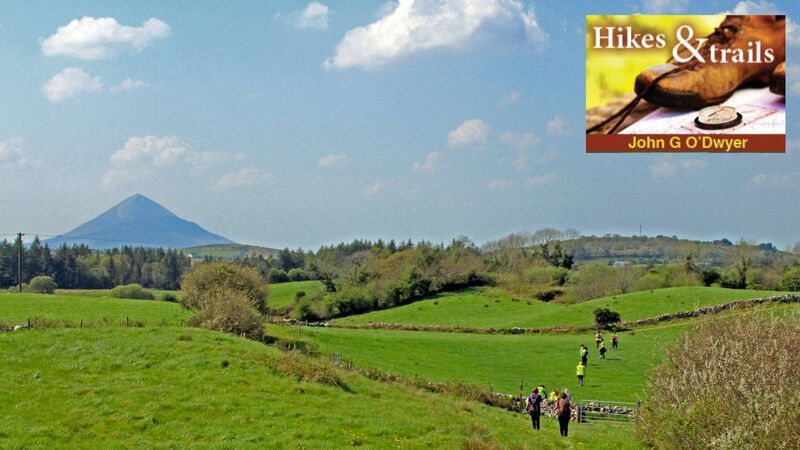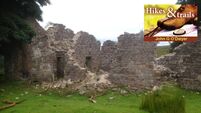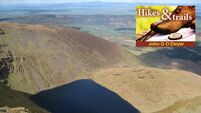Pilgrim trails have come a long way from dangerous and difficult medieval journeys

Tóchar Phádraig Pilgrim Path. Picture: John G O'Dwyer
In medieval times, pilgrimage was about the destination. The journey was merely a long and often dangerous inconvenience leading to a meaningful conclusion. Having gained the holy site, it was believed that sanctity and healing would flow to those arriving with the right intentions.
Many would have made the journey motivated by deep devotion, while others would have been unwilling participants — ordered on pilgrimage to atone for sins. Famously, Armagh man Haneas MacNichaill was obliged to visit 19 places of pilgrimage in Ireland as a penance for murdering his son.
And it wasn’t just the common people who undertook these arduous journeys, for escaping hell fire proved a great medieval leveller. King Henry II of England undertook a redemptive pilgrimage to Canterbury in atonement for the murder of Archbishop Thomas Becket; while the Holy Roman emperor, Henry IV, went barefoot to beg Pope Gregory VII to withdraw his excommunication from the Church.
These days pilgrim walks are not aimed at escaping hell fire, but are undertaken for more personal, holistic or cultural reasons. The journey, not the destination, has become the objective, with the sought-after personal renewal coming not so much from the endpoint as the walk itself.
Until recently, few of the multitudes attracted by the allure of a pilgrim walk along the Spanish Camino would have considered Ireland an alternate destination, mainly because this country was believed to lack penitential trails. On the contrary, Ireland has many mystical paths and a vibrant pilgrim tradition, with all major routes long predating the Camino.
Historically, pilgrimage was an important devotional expression for Irish people with penitents journeying to Glendalough, Gougane Barra, Croagh Patrick, Mount Brandon and Lough Derg.
Later on, during the 19th and 20th centuries, when an emphasis was placed on formal in-church worship, interest in the Irish pilgrim paths quickly evaporated and they became overgrown and largely forgotten.
Now history has come a full circle; people are again taking to these ancient tracks on almost 300 kilometres of fully waymarked trails that follow the steps of penitents past. Pilgrimage these days is vastly different, with little overt emphasis on penance and prayer. Instead, people who follow the ancient spiritual trails of Ireland are generally a more casual and light-hearted bunch.
Coming in brightly coloured and stylish walk-wear, they don’t seek a digital detox and are instead alert for the best selfie points. Some will stay in hostels or camp out, but for the majority, accommodation will be in comfortable hotels and B&Bs, while none will take on the arduous walk home that medieval pilgrims were obliged to undertake. Even the officially organised group walks are non-denominational and relaxed, with more emphasis on history, mindfulness and engaging with the surroundings than on the prayerful origins of the route.
Nevertheless, pilgrim walking isn’t just another form of hiking. As modern expressions of spirituality become more informal and individual, pilgrimage has become as much a personal renewal as a physical journey. Allowing individuals time to step away from the pressures of the 21st century, pilgrim walking provides an opportunity to slow down while reflecting on the purpose of life, with each participant taking a personal meaning from the route. Footing these ageless paths not only offers the opportunity for self-discovery, it also provides a link to the past while bringing welcome spending to Irish rural communities.
A pilgrim journey can be done on a solo walk, a hike with friends, or as part of a fully organised outing. The advantage of choosing an organised walk is that all logistics are taken care of, including the tricky problem of having transport available at the end of each days walk.

For walkers who prefer an organised outing and would like their pilgrim experience to be a smooth one, the Irish Pilgrim Journey, taking place from June 15 to 22, offers the perfect solution. It involves a fully guided mid-summer walk along five of Ireland’s most famous pilgrim paths, with all logistics taken care of.
It enables walkers to obtain the required stamps for the Irish Pilgrim Passport in six days of guided walking and then obtain a Teastas Oilithreachta (completion certificate) from Ballintubber Abbey.
Participants may choose to participate in some or all of the walks. Each walk can be booked individually with the local organisers as follows:
St Finbarr’s Pilgrim Path, Drimoleague, Bantry, County Cork. Tel: 028 31547, Email: davidross316@gmail.com
Cnoc an dTobar Pilgrim Mountain, Cahersiveen County Kerry Tel: 087 7942134, Email: skelligkerry@gmail.com
Cosán na Naomh, Ventry, Dingle, County Kerry Tel, 087 2518174, Email: foh@udaras.ie
St Kevin’s Way, Hollywood, County Wicklow, email: stkevinsway@gmail.com
Tochar Phádráig, Ballintubber Abbey, County Mayo. Tel: 094 9030934 (office hours). Email: info@ballintubberabbey.ie
- For further information, visit: pilgrimpath.ie









